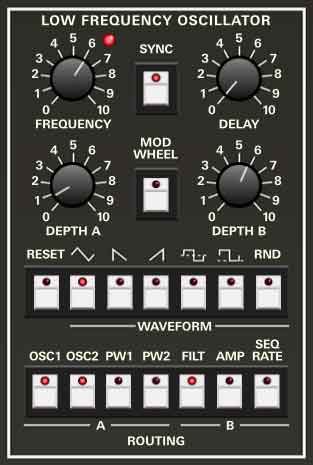Low Frequency Oscillators
Elka-X includes two independent modulation sections - the Low Frequency Oscillator section (i.e. LFO 1) at top left, and the LFO 2 section beneath it. On the original instrument, the Low Frequency Oscillator section (which we'll refer to as LFO 1) was used for static, "always on" modulation, whereas LFO 2 was nominally off and applied dynamically via a joystick. On Elka-X, we've added an Initial Amount parameter to LFO 2 - this lets you use either LFO as a constant mod source.
Low Frequency Oscillator (LFO 1)
Frequency- The Frequency knob sets LFO speed , from 0.02 to 20 Hz (with Sync switch off). The LED beside the Rate knob flashes at the current modulation rate, and visually indicates the curve of the current mod waveform.
Sync- When the Sync switch is enabled, LFO 1 speed will lock to host tempo when using Elka-X within DAW software, or to the current tempo in the top menu bar when using the standalone version. The Frequency knob will snap from 8 beats up to 1/64th note triplets.
Delay- Turning this up gradually delays the onset of LFO depth. The delay time can be up to 30,000 ms (that's 30 seconds for those of you unfamiliar with the metric system). Note that the Low Frequency Oscillator section consists of a single mod oscillator, so mod delay is global for all notes played, and resets when all notes are released.
When the Mod Wheel switch is engaged, the Delay knob grays out and is disabled (because delaying the onset of LFO mod when turning up the mod wheel would be super confusing).
Depth A / Depth B- Elka-X has a nifty and unique "split" mod feature. The Depth A knob sets the amount of mod sent to Oscillator 1 and Oscillator 2 pitches, and Oscillator 1 and Oscillator 2 pulse-width modulation, and the Depth B knob sets the amount of mod sent to filter cutoff frequency, amplitude modulation, and the sequencer play rate.
Note that the Depth A and Depth B knobs only affect the amount of mod; LFO 1 rate is globally controlled by the Frequency knob.
Reset- When enabled, the LFO resets to the beginning of its cycle when a key is played. This functions monophonically - LFO reset only occurs if no other keys are currently held. It's particularly useful for playing synced rhythmic parts in conjunction with the Sync button (as well as the saw and square mod waveforms).
Waveform- Sets the LFO waveform. The waveforms include triangle, sawtooth, ramp, bipolar square, unipolar square, and random .
Regarding the square wave, the original instrument's square was bipolar only. This isn't the greatest if you're trying to set up an alternating note trill. because as mod depth is increased, the low note gets lower and the high note gets higher, making it difficult to set up musical intervals. The unipolar square is much easier to use for pitch modulation, because the bottom note stays constant as mod depth is increased. (The dashed lines in the panel icons indicate the waveform's zero-volt point, in case you ever wondered that meant on your Juno whatever.)
The original also did not have a random (aka, sample-and-hold) wave - we added it for more functionality. Try it as a mod source for Seq Rate - it's pretty wacky!
Routing- Sets the LFO 1 modulation destination(s). A group mod destination amounts are set via the Depth A knob; B group mod destination amounts are set via the Depth B knob. Multiple destinations may be toggled in any combination. Unlike the original, we've added a Seq Rate destination in group B, which can create wild modulated sequencer effects.
LFO 2/Bender and Mod Wheel Destination
In the original instrument, this section contained a four-way joystick for pitch bend, altering the cutoff frequency, or applying triangle-wave LFO mod to pitch (i.e. vibrato) or the filter cutoff (i.e. wah-wah). Obviously we aren't able to make joystick that pops our of your computer display (we're working on it), so instead, we made the LFO 2 section respond to MIDI/USB controller mod wheel data. We also added an Initial Amount slider, which allows the second LFO to stay "on" without using a mod wheel, joystick, or duct tape.
Note that LFO 2 generates a triangle wave only, and is completely independent of the Low Frequency Oscillator section (aka, LFO 1).
Sync- When the Sync switch is enabled, LFO 2 speed will lock to host tempo when using Elka-X within DAW software, or to the current tempo in the top menu bar when using the standalone version. The Initial Frequency slider will snap from 8 beats up to 1/64th note triplets.
Initial Frequency- The Initial Frequency slider sets the nominal LFO speed, from 0.02 to 7.5 Hz (with Sync switch off).
Frequency Accel- This allows the LFO 2 mod rate to speed up when the mod wheel is increased. The higher the setting, the more the LFO rate will increase from the Initial Frequency slider setting.
The front panel label of the original instrument calls this Delta Freq., but we took the liberty of changing it to something a little more descriptive, as we didn't want anyone confusing this control with a faucet (or a cool vintage Korg synth that we should really make a virtual version of...).
To Osc-
To Filter-
LFO2- Sets the max LFO2 modulation applied to the cutoff frequency via the mod wheel.
Bend- Sets the max cutoff frequency mod applied via the pitch bend wheel (i.e. opens and closes the cutoff frequency with the pitch bend wheel).
Upper / Both / Lower mod destination switch- Selects pitch bender and LFO 2 modulation routing to the upper, lower, or both layers.

